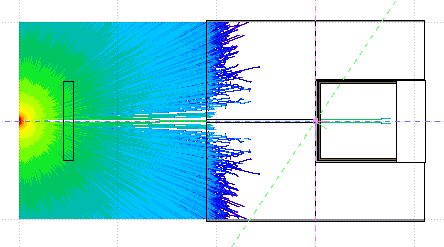I’m currently engaged in determining the mass attenuation coefficient (μ) for specific materials, such as water.
The simulation setup involves a transmission geometry comprising a NaI detector within a lead collimator, a sample, and a pencil beam source of 3 mm in diameter. In this simulation, the photon interactions are defined by Lambert law (I = I0e−μt) for transmitted intensity through a medium.
I implemented the usrbdx scorer to track the transmitted fraction, but I only have zero in the tab.lis and sum.lis files
Could you offer guidance on estimating the transmission fraction (I/I0) using the usrbdx scorer in this scenario ?
I seek clarification on the appropriate utilization of usrbdx for this purpose.
Your expertise and assistance in resolving this matter would be immensely valuable to my study.
I have included my input file below:
Best regards,
mass_23_tab.lis (2.1 KB)
mass_23_sum.lis (4.2 KB)
mass.flair (3.7 KB)
